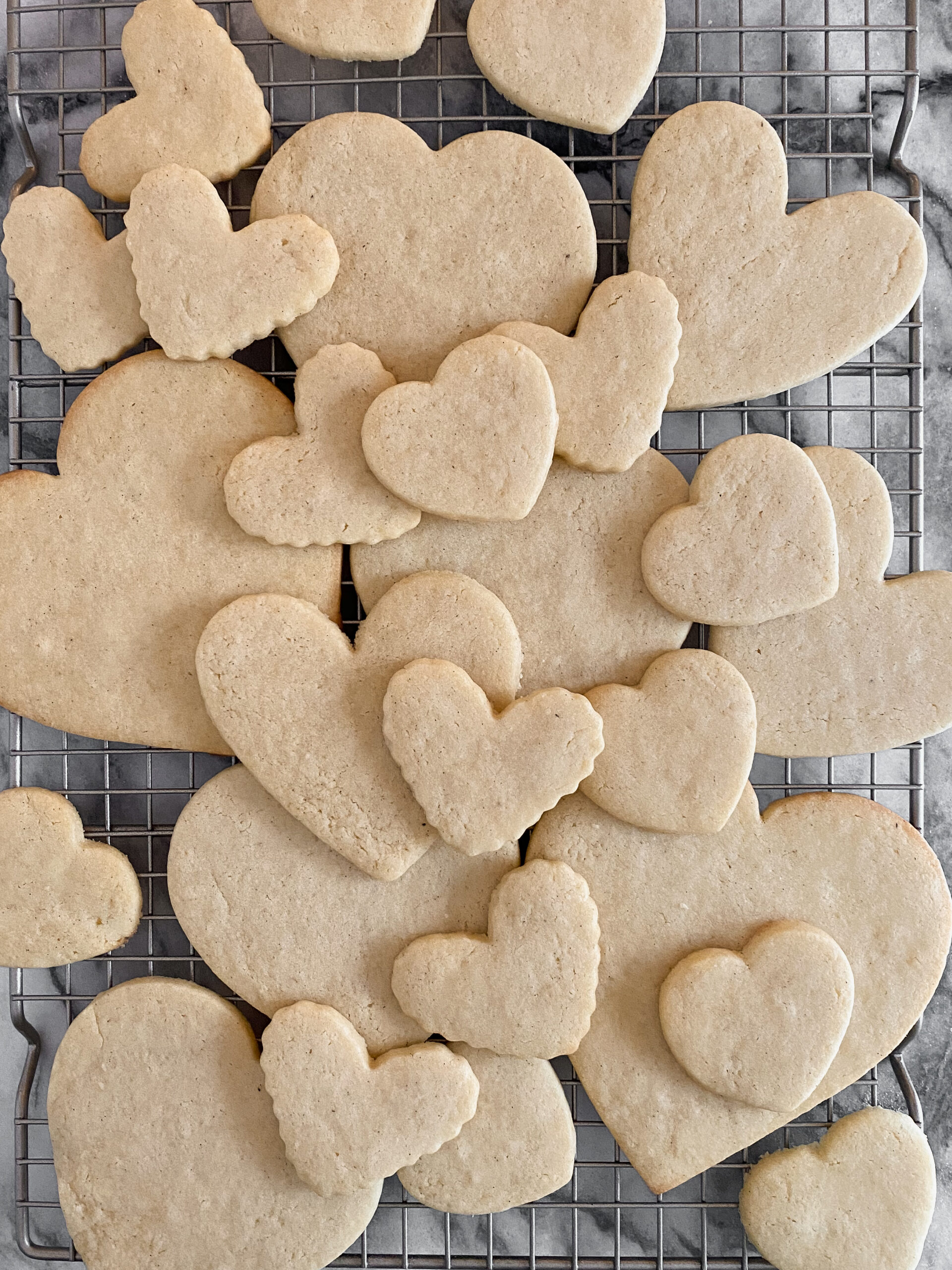
Spread. A cookie decorator’s thorn in the side. The question is always, is your recipe a ‘no spread’ recipe? Or, how do I keep my dough from spreading?
All of the google searches, Facebook group posts, and Instagram highlights all said the same few things. ‘Add more flour. Chill your dough in the freezer. Add corn starch. Take away baking powder. Don’t over cream your butter.’
Some of those things do keep the dough from spreading, but I wanted to know why dough spreads and how the ingredients themselves affect spread through baking science.
I took an online class with a pro, bought some books, and did some testing on the recipe I had been developing for *years*.
Buckle up, and get ready to save this post to your browser reading list.
Disclaimer: I understand that everyone has a different opinion of what a good sugar cookie is like. If you love your recipe and don’t want to change anything, don’t! If things are working great for you, and you do things differently than this post, there is absolutely nothing wrong with that.
why ‘no spread’ can be overrated
Let’s talk about spread. Is it really all that bad? And why do recipes work so hard to prevent it at all costs? (Including *sometimes* sacrificing texture and flavor?)
The obvious reason that a no spread cookie recipe is so desirable is because you want the shape you cut the dough to be the shape you decorate. BUT spread is literally what a cookie is supposed to do in the baking process. It is natural, and a cookie that doesn’t spread at all may be a bit off on ratios. Focusing your recipe only on no spread can cause a cookie to be bland, dry, and tough.
However, there are some tips and tricks you can do using baking science to keep that spread to a minimum, keep the cookie shape, and have nice crisp edges without sacrificing texture and taste.
The key is having a balance between ‘no spread’ and the other important elements of a cookie- texture and flavor.
quick tips for limiting spread right now
butter temp
It is often suggested to use cold butter rather than room temperature butter to prevent spread by making the butter in the dough as cold as possible to prevent it from melting too quickly in the oven. This is true, when butter is cold before it is placed in a hot oven, it takes longer for it to melt. This allows the proteins in the cookie to set by the heat before butter melts. However, using cold butter can prevent the butter/sugar/egg mixture from creaming properly. Little lumps of butter will be present, and once you add egg, no amount of beating will smooth them out. This will cause your dough to be melty in certain places where butter pockets are found. It is best to cream butter when it is between 65 and 70 degrees.
Never melt butter before creaming it, because that breaks the emulsion of water and fat that makes up butter. It is impossible to cream butter and sugar with melted butter, and your dough will be ruined.
If you are in a hurry and forgot to soften your butter, no worries. Plasticizing your butter will make it pliable enough to cream it with your sugar even when it’s cold. Cold butter is made up of large fat crystals, and plasticizing it breaks those crystals down into smaller fat crystals that become pliable and able to cream. A few methods to plasticize your butter: 1) Cut it into small pieces and put it alone in your mixer on low for as long as it needs to soften and become pliable. Make sure to scrape so that the entirety of the butter is smooth, 2) beat your butter with a French rolling pin, preferably between parchment or plastic wrap, until it is a nice thin sheet, 3) chop cold butter in a food processor.
creaming process
The creaming process of butter, sugar, and egg, sets your dough up for success. It creates an emulsion that allows the dry ingredients to incorporate well, and it also incorporates air to give the dough a light and tender texture. Over creaming your butter/sugar/egg mixture can cause spread by adding excessive air to the dough. However, under creaming your dough is probably more common than over creaming. Properly creamed butter and sugar should be smooth with no lumps. The mixture should look perfectly even with no part of it looking different in color or texture. It is so important to scrape the bowl down before adding the egg and vanillas. This is the part that gets tricky. Mixing with the egg is still part of the creaming process, and it is vital to the dough that you properly emulsify the egg mixture. It should be smooth and creamy, with no liquid or lumpy parts. It should also be a bit firm in texture and not runny. Don’t forget to scrape! If any part of the mixture is not even, keep mixing. I prefer to mix on low to medium-low to prevent excessive air buildup. Properly creaming the butter/sugar/egg allows for a stable dough that can hold as little flour as possible.
corn starch
Adding a tablespoon or two to your dough will help limit spread, because corn starch adds stability to a dough and softens the proteins in flour, which also creates a lighter cookie.
oven temp
It is so important that your oven is hot enough. Once the tray of cookies is in the oven, they need to set before the butter melts. A hotter oven will set the cookies more quickly and bake faster, while a cooler oven will melt the butter faster than the cookie sets and bake the cookies more slowly overall. Oven temperature is relative to the thickness of the cookies. If you roll your cookies to ⅜″, you will need a hotter oven than someone who rolls their cookies to 5/16″. Because the dough is thicker, it takes longer to set. Make sure to get an oven thermometer to check that your oven temperature is accurate. (My oven is 15 degrees too cool!)
the different types of sugar cookies
I consider there to be two types of sugar cookies- a buttery base and a sugary base. The buttery base (my favorite) has a lower ratio of sugar to butter and has a more tender crumb with a soft texture similar to shortbread. It tastes amazing when baked to a light golden brown at the bottom and can even be pressed through a cookie press to make spritz cookies. This cookie dough is delicious when rolled thicker (¼″ is my favorite) and baked softer as well as when rolled thin (⅛″ or ⅙″) and baked until golden and crunchy. This recipe is actually based on my family spritz recipe growing up that we used to roll out sugar cookies as well. It’s been a favorite and I’ve kept using it all these years (with a few minor adjustments). Add a little almond extract- mm.
The sugary base cookie has a higher ratio of sugar to butter and is more soft and plush, has a bit of chew, and is usually best when baked to a pale color. This cookie is best when rolled slightly thicker, ¼″ all the way up to ⅜″.
Both of these cookies can be decorated with royal icing or buttercream. Try them both and determine your favorite recipe, tweaking it to be your ideal cookie (whatever that may be).
the standard cookie ratio
The standard cookie ratio is 1:2:3, or one part sugar to two parts butter to three parts flour. In gram measurements, that is 100g (½ cup) granulated sugar, 200g (about 14 Tbsp) butter, and 300g (2 ½ cups) all purpose flour. Essentially, this is a shortbread. With that ratio, you can make plain shortbread cookies starting with that ratio. Add a little salt and vanilla for seasoning, and you have a decent cookie that can be rolled or pressed into a pan.
editing that ratio to make a butter based roll out dough
I’m going to edit that ratio, starting with upping the butter to a full 16 Tbsp, or 226g. The extra butter will add more richness and tenderness to the dough. (Also, isn’t it so annoying to have two tablespoons of butter just hanging out?) The amount of sugar, 100g or ½ cup, can stay the same, but I’ve found that raising the sugar by about two tablespoons for a total of 125g gives the cookie an even better texture. (i.e., softer and more tender) Additionally, I’m going to add an egg for texture and tenderness. It also binds the dough which prevents it from being as crumbly as a shortbread cookie. Next, add some vanilla bean paste (or extract) and a decent amount of salt to season the cookie. I love to also add a little almond extract for another layer of flavor. The amount of flour can stay the same, as it is actually the perfect amount of flour for a cookie that will hold its shape really well. However, if you’re going to put this dough through a cookie press or if you don’t care too much about a little bit of spread, only use 270g (2 ¼ cups) of flour. Using the lower amount of flour makes the cookies taste even better.
editing that ratio to make a sugar based roll out dough
Let’s edit the simple 1:2:3 ratio to make a classic sugar cookie. I’m starting out with 226g of butter (16 Tbsp/1 cup/2 sticks), because I love to develop recipes based on two sticks of butter. It’s just easier. For this ratio, I’m going to double the amount of sugar to be 200g for a nearly 1:1 ratio of sugar to butter. (If you want it to be exactly 1:1, add an additional 25g (2 Tbsp) of sugar. This will give us a softer, sweeter sugar cookie with a bit more of a chew and nice crispy edges. Add an egg and season the dough with vanilla bean paste (or extract), salt, and a little almond extract if you like that. Finally, the flour will need to be increased to make up for the added sugar in this dough. I think 360g (3 cups) is a perfect amount of flour, which gives us a ratio of 1:1:1.6 of sugar : butter : flour. I also like to add a little baking powder to this dough, just to give it a little bit of lift and add to the “fluffiness” of this cookie.
the ingredients of a sugar cookie & what they do
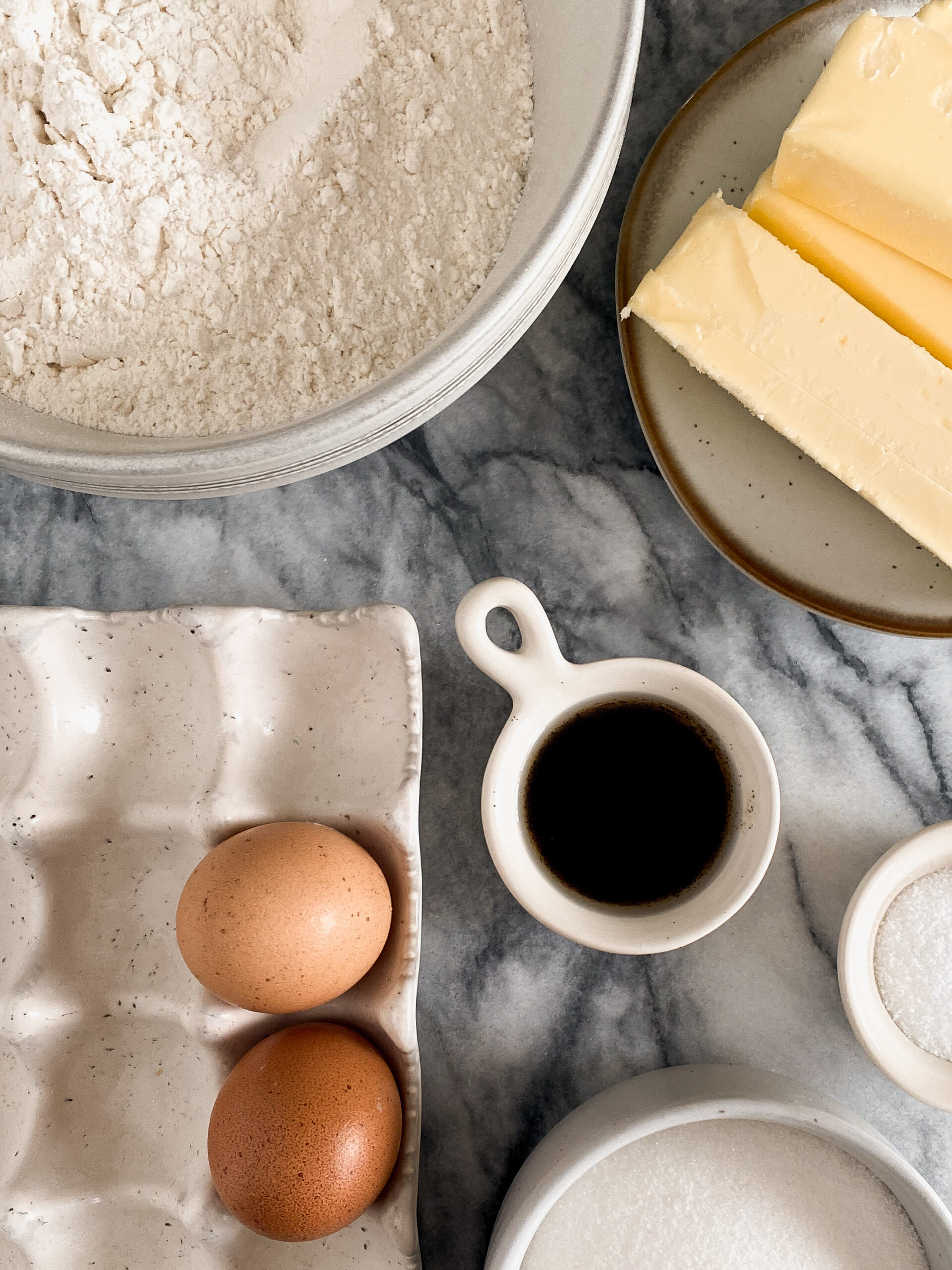
sugar
The courser the granule, the less it dissolves, and the less the cookie spreads. Granulated sugar is the best way to go for sugar in a cut out cookie because its granules are not too course that they won’t dissolve at all, but not too fine that they dissolve too quickly, like powdered sugar. I’ve noticed that cookies with powdered sugar tend to be a little drier and crumblier, which can be great when you’re looking for that texture in a crumbly shortbread-style cookie. After all my testing, I prefer granulated sugar in a cut out sugar cookie recipe.
The amount of sugar in a dough recipe will affect spread. If your dough has too much sugar in it, when it dissolves in the heat of the oven, your dough will spread. Sugar is technically a liquid ingredient because it is hydrophilic (easily dissolved in water) and because it ‘melts’ in heat. Having a proper balance of sugar in your recipe will help with spreading.
Another factor in dough spread is acidity. A more acidic dough will spread less than a less acidic dough, because acid in the dough will help the proteins set more quickly in the oven. A small source of acidity is brown sugar. (You can use light brown sugar or dark brown sugar. Dark brown sugar has more molasses which makes it darker and deeper in flavor. I like to use dark brown sugar when making a cookie with a deeper or richer flavor profile, like chocolate, coffee, toffee, caramel, maple, etc.) Brown sugar will add a bit more moisture to the dough and give the cookie a chewier texture.
I personally prefer classic granulated sugar in my dough, but sometimes will swap a small amount of granulated sugar for brown sugar (usually about a quarter cup). This is especially helpful in recipes that use cocoa powder, because cocoa powder is very drying and that added moisture from the brown sugar balances the texture nicely.
butter
Butter is an amazing fat made from heavy cream. (Did you know that whipping cream is basically another form of butter?!) No other fat will provide the flavor and texture that butter does. Unfortunately, butter is difficult to work with because if it is too cold, it cannot be used properly, and if it is too warm, it melts too quickly.
Butter should be between 65-70 degrees Fahrenheit for the creaming process. Once the dough is made, the dough needs to be chilled to bring the butter back down to a colder temperature. When it is time to bake, it is very important that the oven is at a proper temperature so that the butter doesn’t melt before the proteins in the dough are set.
Always try to use unsalted butter if you can, because you never know how much salt is actually in the butter, and that can throw off the amount of salt in the entire recipe. Salted butter is meant for table/cooking use, and unsalted butter is meant for baking applications. However, if what you have is salted butter, it’s fine. Salted butter is delicious and most likely won’t make your recipe taste saltier unless you have an extremely sensitive-to-salt palate. When using salted butter in a recipe that calls for unsalted butter, try removing ⅛ teaspoon of salt per stick of butter used.
eggs
An egg is three ingredients: a whole egg, a yolk, or a white. An egg white is 90% water and 10% protein, and an egg yolk is 50% water and 50% yolk solids (containing protein, fat, and emulsifiers). The egg as a whole is meant to provide structure in a dough, and the proteins in an egg is what causes the cookie to set in the heat of the oven.
But because an egg has a lot of moisture found in the white, and because we want our roll out dough to spread as little as possible, it can be helpful to remove an egg white from your recipe if you find the dough spreads too much. When I double my buttery based cookie recipe, instead of using two eggs, I prefer to remove an egg white and just use one whole egg and one yolk. This tightens up the dough a bit for less spread while still retaining enough moisture for a delicious cookie.
For an even more tender cookie, you could try using two egg yolks instead of one whole egg. The con to this is that the cookie can lose the crisp edges that adding an egg white can provide as well as having two egg whites to now need to use up. If you love making meringue or egg white royal icing, this may not even be a con.
When eggs are added to butter and sugar in the creaming process, they emulsify and stabilize the mixture, giving it the ability to blend properly with the other ingredients, like flour. Eggs also prevent gluten, which is a protein structure formed by flour that gives structure to doughs. You want a lot of gluten for bread doughs, but you want very little for cookie doughs because you want the dough to be light and tender. Egg fats, proteins, and emulsifiers prevent the gluten formation.
flour
The type and amount of flour will affect your dough recipe. By having a high flour to fat ratio, you can easily achieve a no spread recipe. But if the ratio is unbalanced, you can end up with a tough and dry cookie. The natural thought to preventing spread can be to just add more flour, but if your cookie dough is unbalanced to begin with, adding more flour will only make your cookies tough and dry.
Bleached cake flour is a secret ingredient to a low spread cookie. It has gone through a process that damages its starches and allows them to hold and absorb more moisture than regular flour. Because it is low protein, less gluten can be formed which produces a very tender, soft cookie. If you want to use cake flour, try a blend of 50% bleached cake flour and 50% all purpose flour. Using cake flour can make your cookies so tender that they verge on crumbly, so if that’s not your thing, don’t try this. I used to use this flour blend, but I have since abandoned it due to the cost of cake flour. The improvement of the cookie wasn’t worth the price in my opinion.
baking powder
Baking powder is commonly recommended to be left out of roll out recipes to limit spread, but it actually does not affect spread much at all when used in very small amounts. Baking powder gives lift and tenderness to a dough, and it is sometimes necessary to create a soft and tender cookie. Baking soda causes spread and is used in drop cookies where you would want significant spread. Just remember, baking powder lifts and baking soda spreads.
For the buttery based dough, I do not add baking powder. I’ve tested it out many times, and it isn’t necessary.
For the sugar based dough, I do like to add a little baking powder to give a little lift and fluffiness to the cookie, which prevents it from being too dense.
My best advice on baking powder? Try your recipe with and without it. Try it with a little more or a little less. The only way you’ll know how much you like in your cookie is by trying it a few different ways.
vanilla
Vanilla is the classic flavor in a sugar cookie. The most important element of a good vanilla is that it is dark and pure. It doesn’t need to be the fanciest or most expensive, as long as it has those two qualities.
McCormick Vanilla Extract, which is dark, pure, and cheaper is delicious and works great in a cookie. Kirkland vanilla is a great price and a great option. If you wanted to splurge, some great brands are Nielsen-Massey, and Heilala.
Vanilla bean paste is a game changing ingredient to add to your cookie dough. It adds so much flavor and takes dough to a whole new level. When using vanilla bean paste, you don’t need to add extract to your recipe as it is a 1:1 swap.
My favorite brand for vanilla bean paste will always be Heilala Vanilla Bean Paste. Make sure to shop their sales and bundles for the best prices. Sometimes Costco sells Nielsen-Massey vanilla bean paste, and that is an immediate must-buy-several.
Do not use imitation vanilla as a swap for pure vanilla. Imitation vanilla is usually clear and associated with a birthday cake flavor, which can be delicious when you’re going for that flavor in a cookie. If you’re looking for a smooth, natural vanilla flavor, then you need to get a dark, pure vanilla.
salt
Salt is extremely important in a cookie. Most recipes under-salt. Don’t be afraid of adding salt to your dough! A good balance of salt in a baked good can make a huge difference in flavor. I recommend using Diamond Crystal kosher salt, and all of my recipes use it. It is a lighter salt, so don’t evenly swap for regular table salt. Use about half the amount called for of Diamond Crystal when swapping for table salt. If you can, consider grabbing a big box of Diamond Crystal. It is the recommend-by-chefs salt for baking and cooking, and it is amazing.
baking temperature
Baking temperature can drastically affect your cookie. Baking at a higher temperature (375 F or 400 F) causes the dough to set more quickly, which ultimately prevents spread. Baking at a lower temperature (325 F or 350 F) can cause the dough to melt and spread right away before the dough has time to set.
When baking a cookie with a higher sugar ratio, it is best to not bake at too high a temperature because the high amount of sugar in the dough will cause excessive browning. For the sugary based dough, it is best to bake at 350 F for a soft cookie that doesn’t brown too much and stays moist. Look for the tops of the cookies to be no longer shiny before pulling them out of the oven.
For a buttery based dough, I prefer to bake at 400 F. Since there is a lot of butter in the recipe, baking at a lower temp, like 350 F, can cause the butter to melt out of the dough before it has time to set. The buttery based dough tastes incredible when baked to slightly golden brown, and it is much easier to achieve that coloring when baking at a higher temperature. If you were to bake the cookies at 350 F, it would take too long to achieve that coloring, drying the cookies out.
For my in between recipes, like chocolate based doughs or doughs with freeze dried fruits, I like to bake at 375 F. The in between recipes are buttery based but have a bit more sugar, so I like to lower the temperature to prevent spread and to keep those cookies moist.
I recommend testing your recipe out at different bake temps just to see what you prefer for your recipe.
*Please consider investing in an oven thermometer. They are only about $7 and are extremely important for knowing the temperature of your oven, which can be off by quite a lot. My oven used to be off by 15 degrees before it was adjusted. I like to put my thermometer in the oven when I start the preheating process and allow the oven to preheat for at least 20 minutes. Take a peek at the temperature on the thermometer to see if it is the same as the temperature the oven claims to be. You may be surprised. Adjust the oven temperature as needed before baking your cookies.
is chill time necessary?
I hate to be the bearer of bad news, but, yes. It doesn’t have to be long. Even 30 minutes in the fridge can help set the butter before cutting your cookies. An hour or two is preferred, but if all you have is 30 minutes, it’s fine. To quicken the chill time, put the dough in the freezer instead of the fridge. This cuts down the time significantly. The goal is just to harden the butter in the dough, not to develop flavor like you would with chocolate chip cookies.
My recommended chilling method is this: roll the dough between parchment paper immediately after mixing the dough. Put the sheets of dough in the fridge (or freezer if you’re short on time) until the dough is stiff and holds its shape rather than bending. Cut the cookies as you normally would and place them on a parchment lined baking sheet. Freeze the sheet of cut cookies for five minutes before baking. This final freeze is so helpful in preventing spread! If I’m baking a lot of sheets of cookies, I’ll chill the sheets in the fridge while the others bake to prevent them from getting too frozen.
a few more important notes
proper creaming
Make sure you don’t under cream or over cream the butter and sugar. I know, I know. Mix the butter and sugar on medium speed until it is fully mixed. Don’t cream it to be light and fluffy like you would with a cake. All that air is great when making a plush cake, but aerating a roll out cookie like that will cause spread in the final cookies. After adding the egg, make sure to fully emulsify the mixture. An emulsified mixture will be fully mixed with no lumps, thick, and a bit glossy. Make sure to scrape the bowl and paddle really well during this process.
weighing ingredients
It is so important to weigh your ingredients, specifically your sugar and flours. A cup of flour can have quite a variety of weights depending on how fresh the flour is, how settled it is in your flour container, and how much you pack it into the cup. A cup of flour can be 30g (¼ cup) over or under what it should be. Imagine a recipe calling for three cups, and each was over by ¼ cup? That’s ¾ cup of flour right there that doesn’t need to be in the recipe. Too much flour will make a dry cookie, and not enough will make a cookie that spreads too much. Weighing ensures that you have a perfect dough that is the same every time. Kitchen scales are so easy to use, and they are relatively inexpensive. Not to mention, a scale saves on dishes you would make by using cup measurements.
using guided rolling pins
Guided rolling pins are a game changer. They make rolling dough easy and exact. I like to roll my cookies to ¼″, ⅙″, or ⅛″ depending on the recipe, and having a guided rolling pin makes it much easier. Without a guided rolling pin, you tend to guess, and that means cookies can be much thinner or thicker than the recipe actually calls for. This wooden rolling pin is carved to ¼″, and I use it most often. It also comes in a ⅛″ size.
pre-cut parchment paper
Another game changer. Really, not having to rip or cut parchment paper is niiiice. I love this parchment paper from Kana Lifestyle and having been buying it on repeat for years.
flavoring dough
There are infinite ways to flavor these basic vanilla doughs, but here are a few ideas.
- Vanilla sugar: Try swapping some or all of the sugar in the recipe with vanilla sugar for an extra vanilla boost.
- Maple sugar: Try swapping some or all of the sugar in the recipe with maple sugar for some natural maple flavor.
- Extracts: I love Watkins almond extract, maple extract, peppermint extract, clear vanilla extract, and caramel extract. Heilala sells a wide variety of flavored vanilla extracts that are gorgeous.
- Milk powder: adding a little milk powder to your dry ingredients will give a special richness and boost of flavor to your cookies. Try adding about 1 tablespoon per cup of flour in the recipe. I like to use whole milk powder, toasted whole milk powder, and malted milk powder.
- Brown butter: Brown butter is well known to add a delicious flavor in baking and cooking, and it is especially delicious in cookies. Use only a portion of the butter in the recipe as brown butter, and make sure to chill it to bring it back to a solid before using it in the recipe. Using it as a liquid can cause too much spread in the final cookies. If you find your dough to be a bit crumbly or the baked cookies too dry or crumbly, that means there wasn’t sufficient moisture in the dough. Browning the butter causes the moisture to cook off, so the final cookies could be needing that moisture. If you notice this, try adding an ice cube for every stick of browned butter used. Simply melt it into the browned butter before chilling. The ice cube will add back some of the moisture that was lost in browning. One ice cube is about 1 tablespoon of water if you prefer to use water.
- Citrus zest: This is one of my favorite ways to flavor cookie dough. Zest several lemons, limes, oranges, grapefruits, or a combination of them and rub the zest into the sugar of the recipe with your fingertips to bring out the oils (i.e. flavor) in the zest. Do not add juice to the dough, as that would be adding too much moisture to the dough.
- Freeze dried fruit: Freeze dried fruit powders are an amazing low-moisture and natural way to flavor and color your dough. Start out by adding a few tablespoons to the recipe. If you’re adding more than a few tablespoons, it is a good idea to remove some of the flour in the dough. Try my recipe for strawberry cut out cookies.
- Chocolate: Chocolate is a classic cookie flavor, and it is delicious in a roll out cookie. The simplest way to add big chocolate flavor is through cocoa powder. Natural cocoa powder will not give as much chocolate flavor as Dutch cocoa powder, but both will work. Use black cocoa for an oreo vibe. Start by swapping about ½ cup of flour for cocoa powder in your recipe. Another way to add chocolate flavor is to melt chocolate and incorporate it into your dough with the wet ingredients. Try my chocolate hazelnut cut out cookie recipe.
- Warm spices: Warm spices such as ginger, nutmeg, cinnamon, cardamom, and peppercorns perform beautifully in a cookie dough. Try making a chai spice blend, a gingerbread spice blend, or a pumpkin spice blend to your dough. I love making spice-sugar blends and sprinkling them on cut cookies before baking. Use my code LINENGRAY for 10% off at Spice House.
- Vanilla powder: Vanilla powder is a great way to add vanilla flavor to a cookie without adding more paste or extract. The type of vanilla powder I use is white, which is different than the expensive brown powder that is made from ground vanilla beans.
- Toasted nuts: This is a great mix-in to cookie dough. Just be sure to chop them small so that they don’t interfere with the cookie cutters. You could also grind the nuts finely into a powder and swap some flour for nut flour. Nut flour, like pistachio flour or hazelnut flour is also available in stores like nuts.com.
- Peanut butter: I love this peanut butter brand. They also have peanut powder which is great for adding in cookies. Use my code LINENANDGRAY for 15% off a $50 purchase.
Learn More About Baking Science
If you are interested in the world of baking science, I highly recommend these three books. They are incredible resources that explain things well and offer many different baking techniques and recipes.
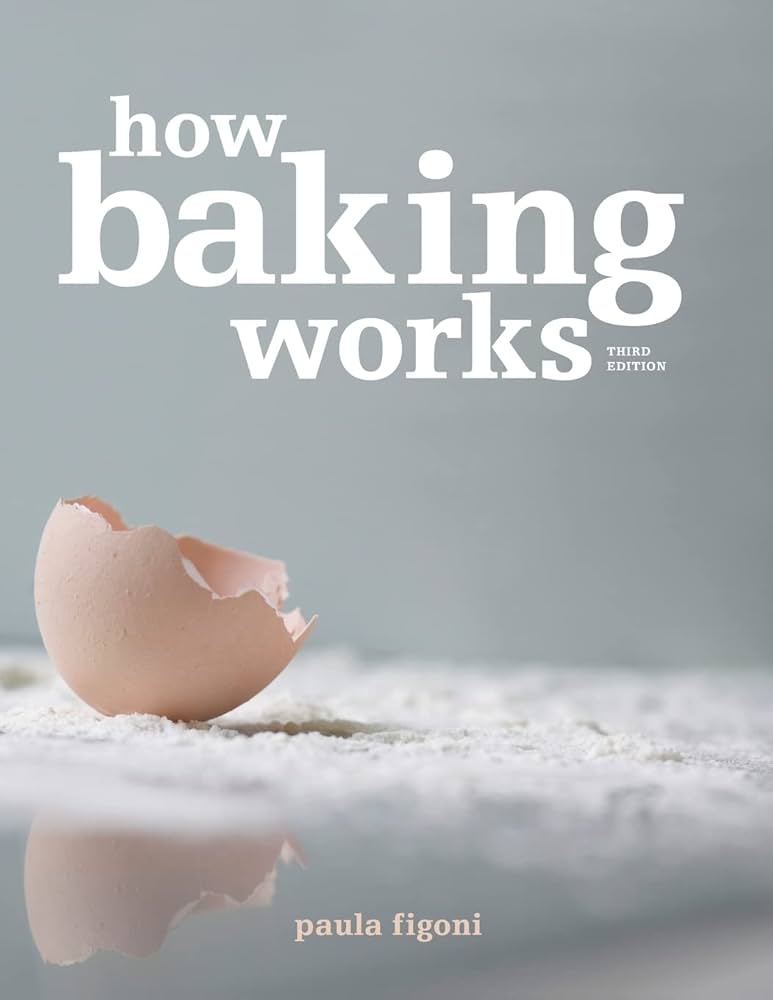
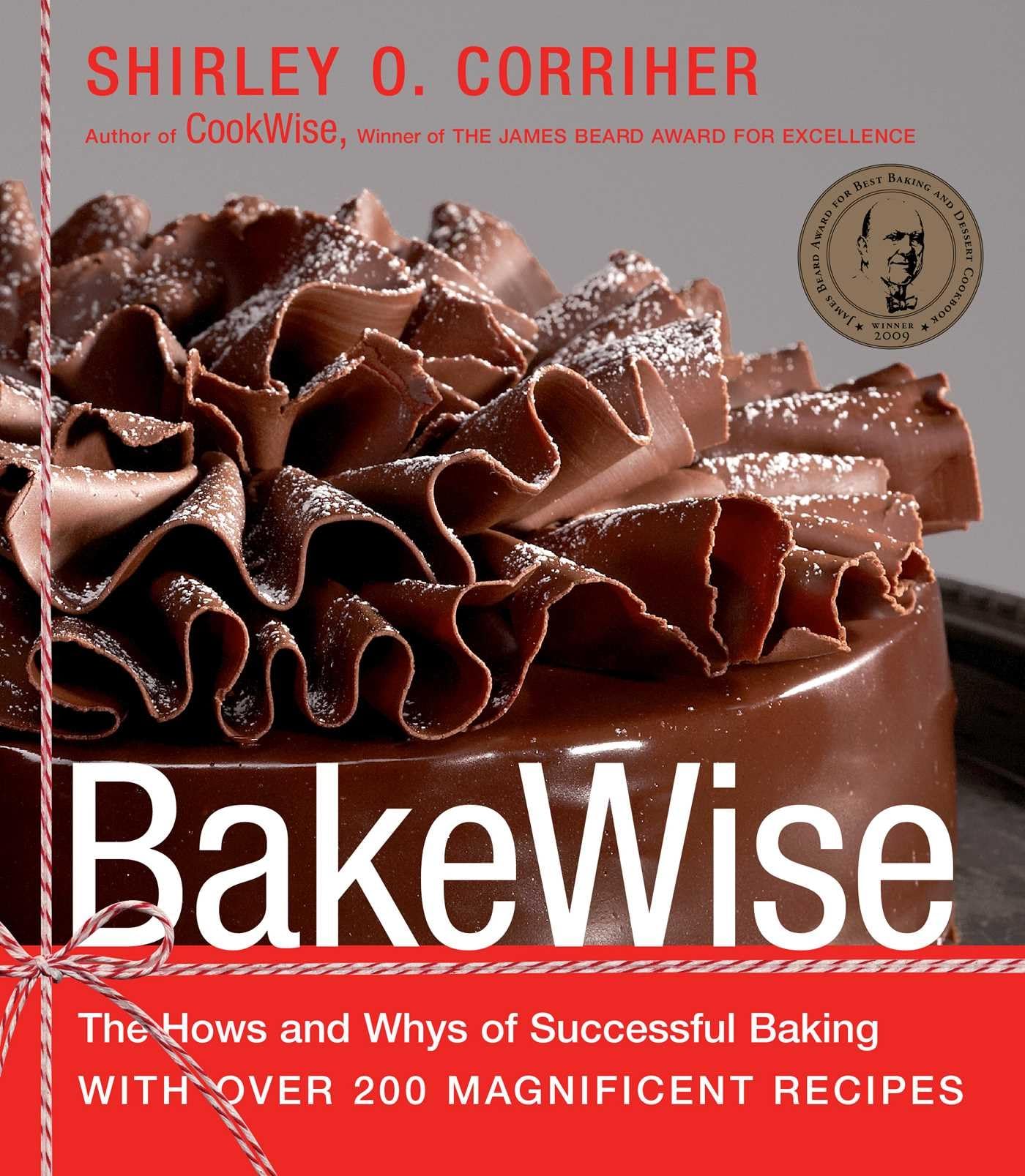

sugar cut out cookies
This classic vanilla sugar cookie cut out has a higher ratio of sugar to butter and is soft and plush, has a bit of chew, and is best when baked to a pale color.
- Yield: 2–3 dozen 1x
Ingredients
226g (1 cup) unsalted butter, room temperature
225g (1 cup + 2 Tbsp) granulated sugar
1 ½ tsp Diamond Crystal kosher salt (or ¾ tsp regular table salt)
1 whole egg, large
1 tsp vanilla bean paste or extract
½ tsp almond extract, optional
360g (3 cups) all purpose flour
¼ tsp baking powder
Instructions
In the bowl of a stand mixer fitted with the paddle attachment (you could alternatively use a hand mixer and a mixing bowl), beat the butter on medium-low speed until smooth. Add the sugar and the salt and mix on medium speed until combined, scraping the sides and bottom of the bowl to ensure that everything is well combined. Add the egg, vanilla, and almond extract (if using) and mix until emulsified, scraping the sides and bottom of the bowl at least once to ensure everything is combined. The mixture should be homogenous, smooth, thick, and glossy.
In a separate bowl, whisk together the flour and baking powder. Add the dry ingredients to the butter mixture and mix on low until the dough comes together. Be careful not to over mix.
Drop the dough onto a lightly floured piece of parchment paper. Sprinkle some additional flour on the surface of the dough before covering with a second piece of parchment. Roll the dough to ¼″, or up to ⅜″ for a very thick cookie. Place the dough in the refrigerator to chill for 1-2 hours or in the freezer for 10-20 minutes.
Preheat the oven to 350 F.
Cut shapes from the chilled dough with lightly floured cookie cutters, placing the cut cookies on a parchment lined baking sheet. Chill the cookies in the refrigerator for 10-15 minutes or in the freezer for 5 minutes. Bake the cookies for 8-10 minutes, or until the tops are no longer shiny. The size and thickness of the cookies will determine how long they bake, so pay attention to the surface of the cookies. Don’t over bake. The cookies should be pale.
Cool the cookies on the cookie sheet for a few minutes before transferring them to a wire rack to cool completely before decorating. Moving them prematurely can result in broken cookies.
Decorate with buttercream or royal icing.
Notes
- This recipe makes 2-3 dozen cookies depending on the size of the cut cookies, the thickness of the roll, and the amount of times the dough is re-rolled.
- I like to re-roll my dough one or two times, maybe three at the most. The best method for re-rolling is to collect the dough scraps all at once at the end of cutting the cookies from all the sheets of dough. Then I gather them into a new dough ball and roll out again. Sometimes the dough is too soft to cut shapes, so I put the sheet in the freezer for 5 minutes to re-chill the butter before cutting cookies again.
- This recipe tastes best when rolled slightly thicker. I don’t recommend using this recipe for thin and crisp cookies.
- Room temperature butter is important in this recipe. Using cold butter can result in little curds of cold butter throughout your final dough, which causes the cookies to spread randomly and look strange. If your butter is coming straight out of the fridge, microwave it for 5 seconds, flipping it over and microwaving it again for 5 seconds until it is pliable. Be careful not to soften it too much.
- Mise en place’ is a French phrase with the idea of putting everything in its place before beginning to make a recipe. It helps everything to go smoothly and eliminates so much possible stress. Getting all of your supplies and ingredients together beforeever starting the recipe will help tremendously.
- Weigh your ingredients, particularly the flour. It is the most important measurement in this recipe to weigh. Flour can be off in volume measurements by up to 30g, which is a quarter cup! Having incorrect flour measurements can cause your cookies to spread too much or, alternatively, be dry and crumbly. Weighing your ingredients makes everything so much easier, as you don’t have to wash all the measuring cups at the end. However, I do not use the scale to weigh out teaspoon or tablespoon measurements for things like baking powder, salt, vanilla, or cornstarch, for example.
butter cut out cookies
This butter cut out cookie has a lower ratio of sugar to butter and has a more tender crumb with a soft texture similar to shortbread.
- Yield: 2–3 dozen 1x
Ingredients
226g (1 cup) unsalted butter, room temperature
125g (½ cup + 2 Tbsp) granulated sugar
1 ½ tsp Diamond Crystal kosher salt, or ¾ tsp regular table salt
1 tsp vanilla bean paste or extract
½ tsp almond extract, optional
300g (2 ½ cups) all purpose flour
Instructions
In the bowl of a stand mixer fitted with the paddle attachment (you could alternatively use a hand mixer and a mixing bowl), beat the butter on medium-low speed until smooth. Add the sugar and the salt and mix on medium speed until combined, scraping the sides and bottom of the bowl to ensure that everything is well combined. Add the egg, vanilla, and almond extract (if using) and mix until emulsified, scraping the sides and bottom of the bowl at least once to ensure everything is combined. The mixture should be homogenous, smooth, thick, and glossy.
In a separate bowl, whisk together the flour and baking powder. Add the dry ingredients to the butter mixture and mix on low until the dough comes together. Be careful not to over mix.
Drop the dough onto a lightly floured piece of parchment paper. Sprinkle some additional flour on the surface of the dough before covering with a second piece of parchment. Roll the dough to ¼″, or up to ⅜″ for a very thick cookie. Place the dough in the refrigerator to chill for 1-2 hours or in the freezer for 10-20 minutes.
Preheat the oven to 400 F.
Cut shapes from the chilled dough with lightly floured cookie cutters, placing the cut cookies on a parchment lined baking sheet. Chill the cookies in the refrigerator for 10-15 minutes or in the freezer for 5 minutes. Bake the cookies for 8-10 minutes, or until the tops are no longer shiny. The size and thickness of the cookies will determine how long they bake, so pay attention to the surface and the bottoms of the cookies. The surface should be no longer shiny, and the bottoms should be golden brown.
Cool the cookies on the cookie sheet for a few minutes before transferring them to a wire rack to cool completely before decorating. Moving them prematurely can result in broken cookies.
Decorate with buttercream or royal icing.
Notes
- This recipe makes 2-3 dozen cookies depending on the size of the cut cookies, the thickness of the roll, and the amount of times the dough is re-rolled.
- I like to re-roll my dough one or two times, maybe three at the most. The best method for re-rolling is to collect the dough scraps all at once at the end of cutting the cookies from all the sheets of dough. Then I gather them into a new dough ball and roll out again. Sometimes the dough is too soft to cut shapes, so I put the sheet in the freezer for 5 minutes to re-chill the butter before cutting cookies again.
- This recipe works best when rolled to ¼″ or 5/16″ for a softer cookie. If you’re looking for a thinner, crunchier butter cookie, lower the flour to 270g and roll to ¼″ or ⅛″.
- If you feel that 400 F is too high for your cookies, and you prefer less browning, lower the temperature of your oven to 375 F and make a note for next time.
- Room temperature butter is important in this recipe. Using cold butter can result in little curds of cold butter throughout your final dough, which causes the cookies to spread randomly and look strange. If your butter is coming straight out of the fridge, microwave it for 5 seconds, flipping it over and microwaving it again for 5 seconds until it is pliable. Be careful not to soften it too much.
- Mise en place’ is a French phrase with the idea of putting everything in its place before beginning to make a recipe. It helps everything to go smoothly and eliminates so much possible stress. Getting all of your supplies and ingredients together beforeever starting the recipe will help tremendously.
- Weigh your ingredients, particularly the flour. It is the most important measurement in this recipe to weigh. Flour can be off in volume measurements by up to 30g, which is a quarter cup! Having incorrect flour measurements can cause your cookies to spread too much or, alternatively, be dry and crumbly. Weighing your ingredients makes everything so much easier, as you don’t have to wash all the measuring cups at the end. However, I do not use the scale to weigh out teaspoon or tablespoon measurements for things like baking powder, salt, vanilla, or cornstarch, for example.



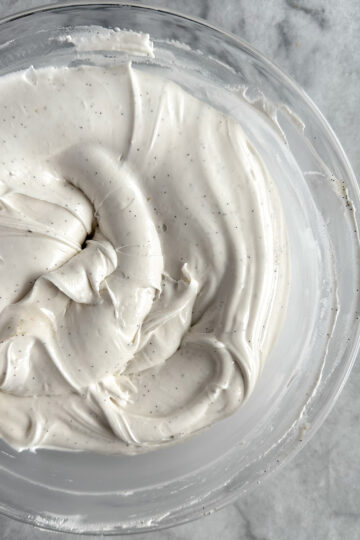


Denise says
What a brilliant and generous post! I cannot wait to play with my recipes using your tips and tricks. Thank you so much for sharing this treasure trove of information!
Keisha says
Wow! That was such a great explanation. Thank you Emily! I xurrentlyndont have any sleeas.wirh my recipes but I do want to try adding the cake flour. Thank you for putting this well put blog. 👏
Kaitee Doll-Bell says
Fantastic information! I learned so much. Thank you for sharing.